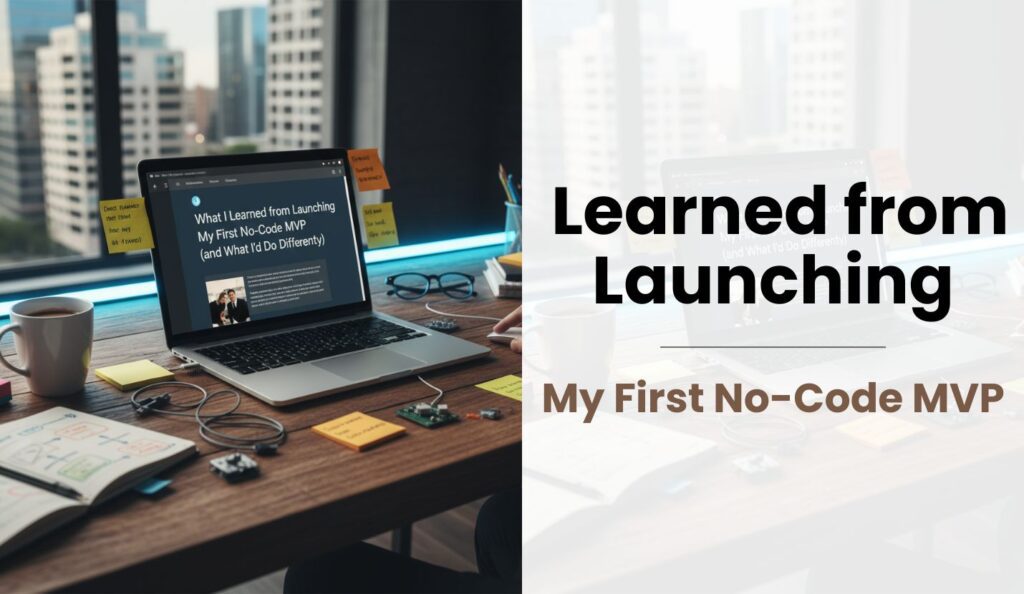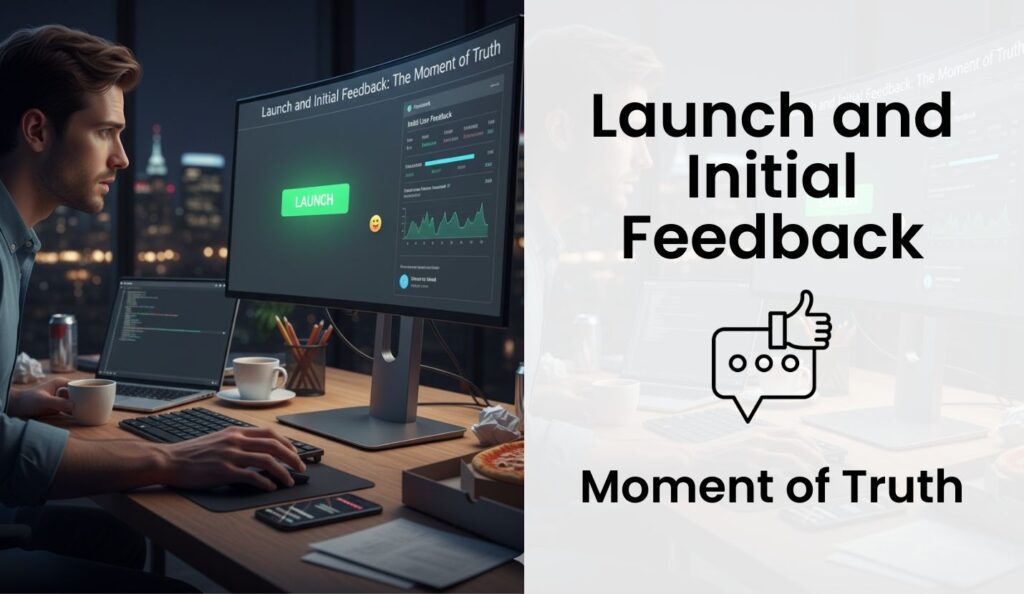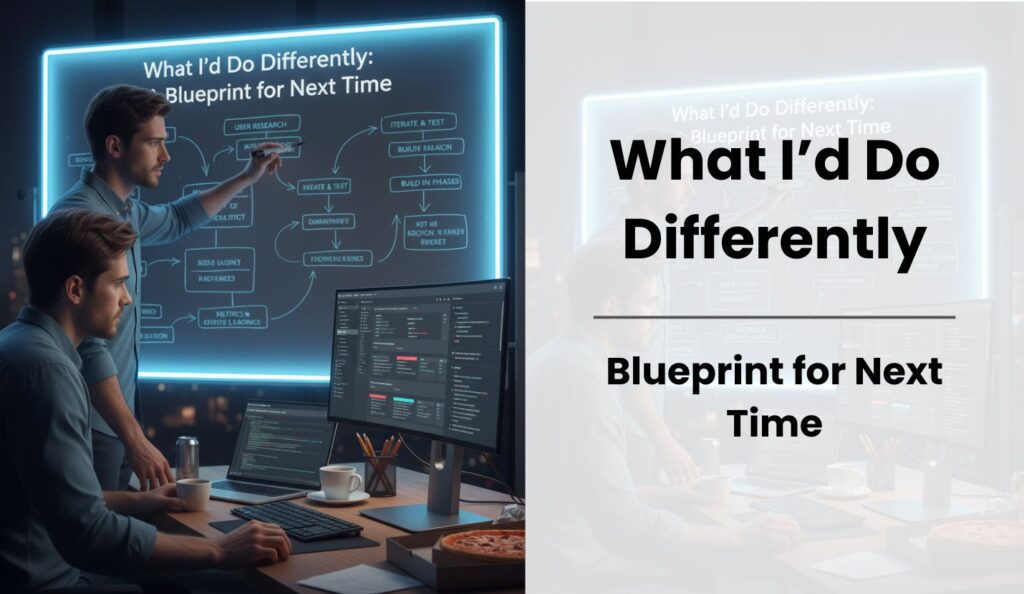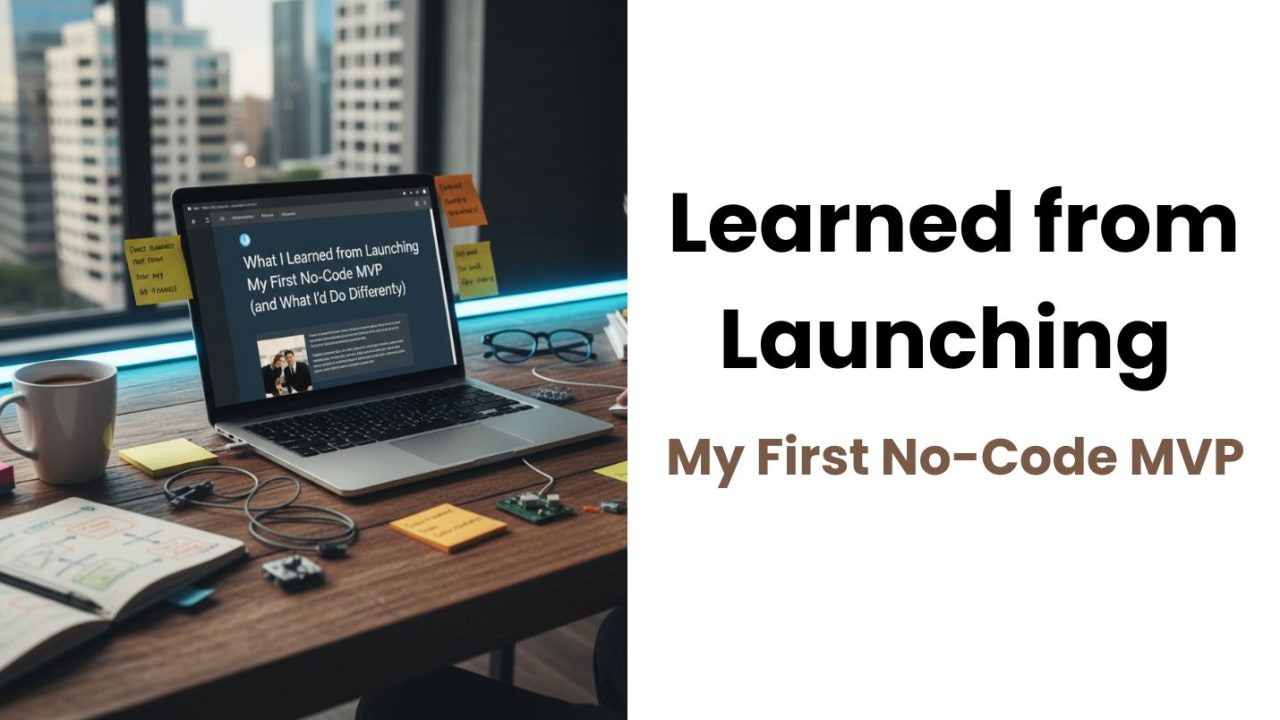The journey of an entrepreneur is often painted with broad strokes of success, but the reality is a mosaic of trial, error, and profound learning. Launching a Minimum Viable Product (MVP) is a rite of passage for many, and doing so with no-code tools adds a unique layer to this experience. My recent foray into the no-code world, culminating in the launch of my first MVP, was an eye-opening adventure. It was a whirlwind of excitement, frustration, unexpected breakthroughs, and invaluable lessons. This article is a candid reflection on that experience, detailing what I learned and, more importantly, what I would approach differently if I had the chance to do it all over again.
The promise of no-code is alluring: rapid development, reduced costs, and the ability for anyone, regardless of technical background, to bring their ideas to life. This democratizing power is what drew me in. I had an idea, a perceived market need, and a burning desire to create something impactful without getting bogged down in complex coding languages. My goal was to build a simple, AI-powered tool that would help small businesses generate personalized marketing copy quickly and efficiently. The vision was clear, the tools seemed accessible, and my enthusiasm was boundless. What could go wrong?
Launch Your App Today
Ready to launch? Skip the tech stress. Describe, Build, Launch in three simple steps.
BuildAs it turns out, quite a bit – and also, quite a lot went right. The beauty of the MVP approach, especially with no-code, is that it forces you to confront reality quickly. It strips away assumptions and exposes the raw truth of your product’s viability and your process’s effectiveness. This narrative isn’t just a recount of my journey; it’s a guide for aspiring no-code founders, designed to illuminate the path and help you sidestep some of the pitfalls I encountered.

The Genesis of an Idea: Identifying the Problem and Crafting the Vision
Every product starts with a problem. For me, it was witnessing countless small business owners struggle with consistent, high-quality marketing content. They often lacked the budget for professional copywriters or the time to craft compelling messages themselves. The advent of generative AI seemed like a perfect solution, but most AI tools were either too complex for non-technical users or too generic to provide truly personalized output. This was my ‘aha!’ moment: an AI-powered, no-code platform that simplified content generation for small businesses.
My initial vision was ambitious. I envisioned a platform that could generate blog posts, social media captions, email newsletters, and even ad copy, all tailored to specific industries and brand voices. It would be intuitive, fast, and affordable. The ‘no-code’ aspect was crucial – I wanted to build it myself, without hiring developers, to keep costs low and maintain full control over the product’s evolution. This approach promised not just speed but also a deep understanding of the user’s perspective, as I would be both the builder and a potential user.
Choosing the Right No-Code Stack
Selecting the right no-code tools felt like navigating a vast, exciting, but sometimes overwhelming marketplace. I researched various platforms, considering their capabilities, pricing models, and community support. My primary requirements were: robust database management, intuitive UI/UX building, and strong integration capabilities, especially with AI APIs. I needed a platform that could handle text input, process it through an AI model, and display the output cleanly.
After much deliberation, I settled on a combination of Bubble for the frontend and backend logic, integrated with OpenAI’s API for the core AI functionality. I also used Zapier for various automations and Airtable for initial data organization. This stack allowed for significant flexibility and power without writing a single line of traditional code. Learning to leverage these tools effectively was a mini-journey in itself, requiring a shift in thinking from traditional programming paradigms to a more visual, logic-based approach. For those looking to get started, exploring top no-code MVP tools for indie hackers can provide a great starting point.
Building the MVP: Process, Challenges, and Key Features
The build phase was intense. I dedicated evenings and weekends to designing the interface, setting up the database, and configuring the workflows. The core functionality involved a user inputting details about their business and desired content, which then triggered an API call to OpenAI. The AI’s response was then formatted and displayed to the user. This seemingly simple flow involved numerous smaller steps and conditional logic within Bubble.
Key features of my MVP included:
- User Authentication: Secure login and signup.
- Content Prompts: Pre-defined templates for different content types (e.g., social media post, email subject line).
- Custom Inputs: Fields for users to add specific details about their business, product, and target audience.
- AI Integration: Connecting Bubble to OpenAI’s API for content generation.
- Output Display & Editing: A clean interface to view and make minor edits to the generated content.
- History & Saving: Users could save their generated content for future reference.
Challenges were plentiful. One of the biggest was understanding API calls and data structures. While no-code abstracts away the syntax, understanding how data flows between different services is crucial. Debugging workflows when an API call failed or data wasn’t formatted correctly was a significant learning curve. Another challenge was optimizing the user experience; making sure the interface was intuitive and the content generation process felt seamless. I also spent a considerable amount of time refining my prompt engineering tips for no-code AI developers to ensure the AI generated high-quality, relevant outputs.
Launch and Initial Feedback: The Moment of Truth

After approximately three months of focused building, the MVP was ready for its soft launch. I shared it with a small group of target users – friends who owned small businesses, fellow entrepreneurs in online communities. The initial feedback was a mix of excitement and constructive criticism. Users loved the speed and the potential for personalized content, but they also pointed out areas for improvement:
- The onboarding process was confusing.
- Some generated content felt too generic, despite my prompt engineering efforts.
- There were occasional bugs in the saving functionality.
- The pricing structure I initially proposed was unclear.
This feedback was invaluable. It confirmed that there was a genuine need for the product, but also highlighted critical flaws that I, as the builder, had overlooked. This early validation, even with its criticisms, was incredibly motivating. It showed that my hypothesis was largely correct, but my execution needed refinement. It also underscored the importance of not just building, but building with a constant feedback loop.
Key Learnings: What I Discovered Along the Way
My no-code MVP launch taught me more than any textbook ever could. Here are the most significant lessons:
1. Validation is King, But Don’t Over-Optimize
I spent a good amount of time validating my idea before building, conducting surveys and interviews. This was crucial. However, I found myself in analysis paralysis at times, trying to perfectly predict every user need. The real validation came post-launch. The lesson: validate enough to ensure a market exists, then build, launch, and let real-world usage provide the deepest insights. Don’t let the pursuit of perfect validation delay your launch. A great example of this is seen in a SaaS MVP with AI no-code complete case study, where rapid iteration post-launch proved more effective than prolonged pre-launch analysis.
2. Scope Creep is Real, Even with No-Code
It’s easy to get carried away with features, especially when building is so fast. My initial vision was already quite broad, and during development, I kept thinking, “Oh, I could just add X feature, it’s so easy with no-code!” This led to a slightly bloated MVP that took longer to launch and had more surface-level bugs. The key is ruthless prioritization. Stick to the absolute core functionality that solves the primary problem. Anything else is for version 2.0.
3. Design (UI/UX) Matters Immensely
Even with a functional product, a clunky or confusing interface can deter users. I initially focused heavily on functionality, assuming users would overlook minor UI imperfections. I was wrong. A clean, intuitive design significantly impacts user adoption and satisfaction. Investing time in thoughtful UI/UX design, even with no-code tools, pays dividends. Consider platforms that facilitate AI-driven personalization in no-code web app guides to enhance user experience from the start.
4. Marketing is Not an Afterthought
I made the classic mistake of focusing almost entirely on building, assuming that once the product was live, users would magically appear. Marketing needs to start long before launch. Building an audience, creating anticipation, and understanding how to reach your target users are just as important as the product itself. My post-launch scramble to understand basic marketing strategies highlighted this critical oversight.
5. Data and Analytics are Crucial from Day One
Understanding how users interact with your product is vital for iteration. I integrated basic analytics tools, but not robust enough ones. I wished I had more detailed insights into user flows, drop-off points, and feature usage. This data is the fuel for informed decisions about what to improve or build next. It’s not just about knowing *if* people use your app, but *how* they use it.
6. Community and Support are Invaluable
The no-code community is incredibly supportive. I leveraged forums, tutorials, and online groups to overcome technical hurdles. Having a network of fellow builders to ask questions and share insights with accelerated my learning process significantly. Don’t try to go it alone; embrace the collective knowledge.
7. The Power of Iteration is Real
An MVP is not a finished product; it’s a starting point. The lessons learned from the initial launch fueled rapid iterations. Each piece of feedback was an opportunity to refine, simplify, or enhance. This agile approach, facilitated by no-code’s speed, allowed me to quickly pivot and improve the product based on real user needs. This continuous improvement is a core tenet of best practices for AI in no-code apps.
8. Technical Debt Exists Even in No-Code
While no-code reduces traditional coding debt, it introduces its own form of “workflow debt.” Overly complex workflows, redundant database fields, or inefficient API calls can lead to slower performance and make future changes difficult. It’s important to design your no-code logic as cleanly and efficiently as possible from the outset, just as you would with traditional code. Planning for no-code app scalability is essential to avoid hitting performance bottlenecks.
9. Pricing Strategy Needs Early Consideration
I deferred thinking about pricing until very late in the process. This was a mistake. Pricing is part of your product’s value proposition and needs to be tested and refined just like features. Understanding your target market’s willingness to pay and communicating that value clearly is critical for monetization. This includes understanding the cost optimization for AI APIs in no-code projects to ensure your pricing model is sustainable.
10. Don’t Underestimate the Emotional Rollercoaster
Launching an MVP is an intense emotional experience. There are highs of seeing your idea come to life and lows of encountering unexpected bugs or negative feedback. Maintaining resilience, celebrating small wins, and learning to detach from outcomes are crucial for mental well-being throughout the entrepreneurial journey.
What I’d Do Differently: A Blueprint for Next Time

Hindsight is 20/20, and armed with these lessons, my approach to the next no-code MVP would be significantly different. Here’s my revised blueprint:
1. More Rigorous Pre-Validation (with a Twist)
Instead of just surveys, I’d create a “concierge MVP” first. This means manually performing the core service for a few customers to deeply understand their pain points and desired outcomes before building anything. For example, I would have manually generated marketing copy for a few businesses using AI tools, delivering it to them and gathering feedback. This ‘human-powered’ MVP would provide richer insights than surveys alone and confirm willingness to pay. This is a crucial step for any aspiring entrepreneur looking to launch your SaaS in 30 days with a no-code action plan.
2. Start Even Simpler: The “Single Feature” MVP
My MVP, while lean, still tried to do too much. Next time, I would focus on one single, killer feature that solves one specific problem exceptionally well. For my marketing copy tool, this might have been just “social media caption generation” for a very niche industry. This ultra-lean approach reduces build time, simplifies testing, and makes it easier to get clear feedback on the core value proposition.
3. Build in Public and Market from Day One
Instead of building in secret, I would actively document and share my building journey on social media, blogs, and relevant communities. This “build in public” approach generates interest, gathers early feedback, and builds an audience before launch. Marketing would be an ongoing activity, not a post-launch scramble. This includes setting up an automated email marketing workflow with Zapier and ChatGPT from the outset.
4. Prioritize Onboarding and First-User Experience
The initial moments a user spends with your product are critical. I would invest significantly more time in crafting a smooth, intuitive onboarding flow that clearly communicates the product’s value and guides users to their first success. This might involve interactive tours, clear instructional text, or even a short video tutorial. A smooth onboarding experience is paramount for retaining users and reducing churn, especially when you consider how to automate customer onboarding using AI.
5. Focus on a Niche, Then Expand
My initial target market was “small businesses,” which is still too broad. Next time, I’d pick a highly specific niche – e.g., “boutique florists in urban areas” – and tailor the product and messaging specifically for them. This allows for clearer value proposition, easier marketing, and more targeted feedback. Once successful in one niche, expansion becomes a more natural, data-driven process.
6. Automate More with AI and No-Code
The power of no-code combined with AI is immense. I would look for more opportunities to automate internal processes, customer support, and even parts of the user journey. For example, using AI to categorize customer feedback or generate personalized follow-up emails. This frees up time to focus on core product development and customer engagement. Consider how to deploy AI chatbots on your website without code for instant customer support.
7. Plan for Integrations from the Start
Many no-code apps benefit from integrations with other popular tools (e.g., CRM, email marketing platforms). While my MVP had basic API connectivity, I would plan for seamless, user-friendly integrations from an earlier stage. This enhances the product’s utility and stickiness within a user’s existing workflow. Understanding how to add AI to your app with no-code is a crucial step in this planning.
8. Prioritize Security and Compliance
Even for an MVP, security and data privacy cannot be an afterthought. With AI models handling sensitive business information, ensuring data encryption, secure API handling, and clear privacy policies are paramount. I would research and implement GDPR compliance in no-code tools and other relevant security best practices from the very beginning to build trust and avoid future headaches.
9. Develop a Clear Monetization Strategy Early
Instead of vague pricing ideas, I would develop a concrete monetization strategy, including different tiers and features, and test it with potential users. This helps refine the value proposition and ensures the product is not just useful but also sustainable. This also involves a clear understanding of AI and no-code tool pricing to inform your own strategy.
10. Continuous Learning and Adaptation
The no-code and AI landscape is evolving at an incredible pace. What’s cutting-edge today might be standard tomorrow. I would commit to continuous learning, staying updated with new tools, features, and best practices. This adaptability is key to long-term success in this dynamic environment. For example, understanding the nuances of ethical AI in no-code is becoming increasingly important.
The Future of No-Code and AI: Building Smarter, Not Harder
My experience reaffirmed the immense potential of no-code tools, especially when combined with the power of artificial intelligence. This synergy allows individuals and small teams to build sophisticated applications that were once the exclusive domain of large engineering departments. The barrier to entry for innovation has been dramatically lowered, fostering a new wave of entrepreneurship.
As AI continues to advance, its integration into no-code platforms will only deepen. We’ll see more intelligent builders, more sophisticated automation, and even AI-driven optimization of no-code workflows. This means even faster development cycles, more personalized user experiences, and the ability to solve increasingly complex problems without writing traditional code. The future of product development is undeniably moving towards more accessible, AI-augmented creation.
Conclusion: Embrace the Journey, Learn from Every Step
Launching my first no-code MVP was a transformative experience. It wasn’t perfect, and I made my share of mistakes, but each misstep was a valuable lesson disguised as a setback. The key takeaway is this: don’t be afraid to launch. Get your idea out there, even if it’s imperfect. The real learning begins when your product meets real users.
The no-code movement, augmented by AI, empowers creators like never before. It allows us to iterate rapidly, test hypotheses quickly, and bring innovative solutions to market with unprecedented speed and efficiency. My journey reinforced that success isn’t about avoiding mistakes; it’s about learning from them, adapting, and continuously striving to build better, more impactful products. So, if you have an idea simmering, take the leap. Start building, start learning, and embrace the incredibly rewarding adventure of no-code entrepreneurship.
Frequently Asked Questions
What is a No-Code MVP?
A No-Code MVP (Minimum Viable Product) is the simplest version of a product built using no-code development platforms, designed to gather validated learning about customers with the least amount of effort. It focuses on core functionality to solve a primary problem without writing any traditional code, enabling rapid development and market testing.
Why choose No-Code for an MVP?
No-code platforms significantly reduce development time and cost, allowing entrepreneurs without technical backgrounds to build and launch products quickly. This speed enables faster market validation, quicker iteration based on user feedback, and a lower financial risk compared to traditional coded development.
What are common challenges when launching a No-Code MVP?
Common challenges include managing scope creep, ensuring robust UI/UX design, effective marketing and user acquisition, integrating complex APIs (especially AI), understanding and optimizing no-code workflows, and planning for future scalability and technical debt. Debugging and performance optimization can also be tricky without traditional coding knowledge.
How important is user feedback for a No-Code MVP?
User feedback is paramount for an MVP. It provides critical insights into what works, what doesn’t, and what users truly need. No-code’s rapid iteration capabilities mean that feedback can be quickly incorporated into product improvements, guiding the product’s evolution based on real-world usage rather than assumptions.
What should I prioritize when building my first No-Code MVP?
Prioritize rigorous pre-validation to confirm market need, focus on a single, core feature that solves one specific problem exceptionally well, invest in intuitive UI/UX design, start marketing and building an audience from day one, and integrate robust analytics to understand user behavior. Also, plan for scalability and security early on.
Can No-Code MVPs scale?
Yes, many no-code platforms are built to handle significant scale, though it depends on the platform and how the application is structured. Planning for scalability from the outset, optimizing workflows, and understanding the platform’s limitations and pricing models are crucial for growth. For advanced needs, hybrid approaches (no-code with some custom code) might be considered.
How does AI integrate with No-Code MVP development?
AI can be integrated into no-code MVPs through APIs (Application Programming Interfaces) offered by AI services like OpenAI, Google AI, or various AI marketplaces. No-code platforms can connect to these APIs to leverage AI capabilities such as natural language processing, image recognition, data analysis, and content generation, enhancing the product’s intelligence and automation.
What’s the biggest mistake to avoid when launching a No-Code MVP?
The biggest mistake is often building in isolation and waiting for perfection before launching. This leads to wasted time and resources on features users might not even want. Instead, launch a truly minimal product quickly, gather feedback from real users, and iterate based on validated learning. Also, neglecting marketing until after launch is a common pitfall.
Is security a concern with No-Code platforms?
Security is a concern with any platform, no-code included. Reputable no-code platforms implement robust security measures, but developers must also adhere to best practices for data handling, API key management, user authentication, and privacy compliance (e.g., GDPR). Always research the security features and compliance certifications of your chosen no-code tools.
What is the ‘build in public’ approach, and why is it beneficial for No-Code MVPs?
The ‘build in public’ approach involves openly sharing your development journey, progress, challenges, and learnings with an audience. For no-code MVPs, it’s beneficial because it helps build an early community, generates interest and anticipation for the product, gathers valuable feedback throughout the development process, and can serve as a powerful marketing strategy even before launch.
Launch Your App Today
Ready to launch? Skip the tech stress. Describe, Build, Launch in three simple steps.
Build




